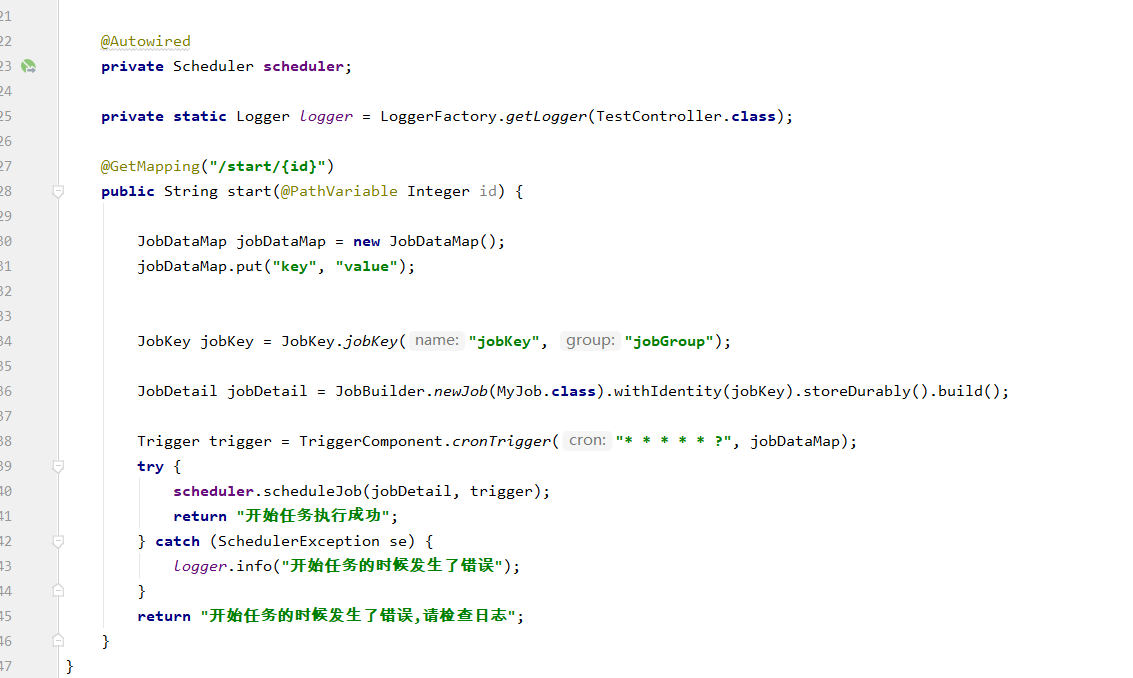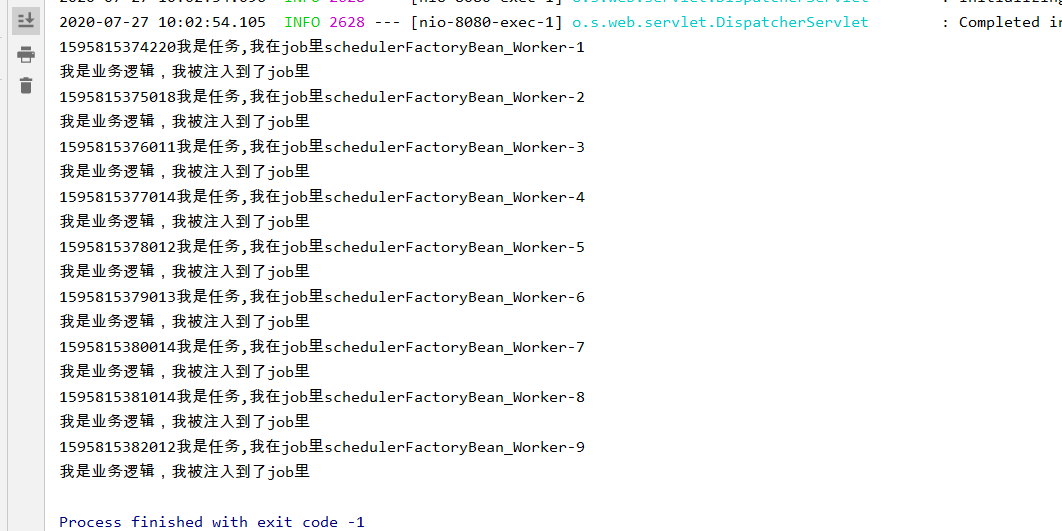這篇文章給大家介紹springboot+quartz以持久化的方式實現定時任務,詳情如下所示:
篇幅較長,耐心的人總能得到最后的答案小生第一次用quartz做定時任務,不足之處多多諒解。
首先
在springboot項目里做定時任務是比較簡單的,最簡單的實現方式是使用**@Scheduled注解,然后在application啟動類上使用@EnableScheduling**開啟定時任務。
示例
|
1
2
3
4
5
6
7
8
9
10
11
12
13
14
|
@SpringBootApplication@EnableSchedulingpublic class Application { public static void main(String[] args) { SpringApplication.run(Application.class, args); } // cron為每秒執行一次 @Scheduled(cron = "* * * * * ?") public void print(){ System.out.println("執行定時任務"); }} |
######結果
執行定時任務
執行定時任務
執行定時任務
執行定時任務
執行定時任務
執行定時任務
執行定時任務
執行定時任務
簡單的定時任務就可以用這種方式來做,cron表達式的結果為任務執行的間隔時間。
然而
實際開發中,我們的任務可能有很多,且需要手動操作單個/全部的任務,比如添加、開啟、停止、繼續等等操作。那么伴隨著(千牛B類。。。)的BGM有請quartz登場。
quartz
整合
|
1
2
3
4
|
<dependency> <groupId>org.springframework.boot</groupId> <artifactId>spring-boot-starter-quartz</artifactId></dependency> |
quartz的三要素
- 調度器Scheduler
- 啟動觸發器去執行任務
- 觸發器Trigger
用來定義Job(任務)觸發條件、觸發時間,觸發間隔,終止時間等
任務job
具體要執行的任務內容
使用
使用quartz是需要配置文件的,quartz.properties在quartz的jar包的org.quartz包下可以找到默認的配置文件quartz.properties
|
1
2
3
4
5
6
7
8
9
10
11
12
13
14
15
16
17
18
19
20
|
# Default Properties file for use by StdSchedulerFactory# to create a Quartz Scheduler Instance, if a different# properties file is not explicitly specified.## 名字org.quartz.scheduler.instanceName: DefaultQuartzSchedulerorg.quartz.scheduler.rmi.export: falseorg.quartz.scheduler.rmi.proxy: falseorg.quartz.scheduler.wrapJobExecutionInUserTransaction: false# 實例化ThreadPool時,使用的線程類為SimpleThreadPoolorg.quartz.threadPool.class: org.quartz.simpl.SimpleThreadPool# 線程總個數org.quartz.threadPool.threadCount: 10# 線程的優先級org.quartz.threadPool.threadPriority: 5org.quartz.threadPool.threadsInheritContextClassLoaderOfInitializingThread: trueorg.quartz.jobStore.misfireThreshold: 60000# 持久化方式,默認持久化在內存中,后面我們使用db的方式org.quartz.jobStore.class: org.quartz.simpl.RAMJobStore |
quartz任務持久化到db則需要一些官方定義的數據庫表,表的sql文件可以在quartz的jar包里找到
坐標org.quartz.impl.jdbcjobstore,可以看到里面有很多sql文件,有各種數據庫的,咱們用MySQL的,咱們不需要手動執行sql語句,后面咱們在啟動項目的時候自動初始化。
創建我們自己的properties文件
|
1
2
3
4
5
6
7
8
9
10
11
12
13
14
15
16
17
18
19
20
21
22
|
# 實例化ThreadPool時,使用的線程類為SimpleThreadPoolorg.quartz.threadPool.class=org.quartz.simpl.SimpleThreadPool# threadCount和threadPriority將以setter的形式注入ThreadPool實例# 并發個數org.quartz.threadPool.threadCount=10# 優先級org.quartz.threadPool.threadPriority=5org.quartz.threadPool.threadsInheritContextClassLoaderOfInitializingThread=trueorg.quartz.jobStore.misfireThreshold=5000#持久化使用的類org.quartz.jobStore.class=org.quartz.impl.jdbcjobstore.JobStoreTX#數據庫中表的前綴org.quartz.jobStore.tablePrefix=QRTZ_#數據源命名org.quartz.jobStore.dataSource=qzDS#qzDS 數據源,我們使用hikaricp,默認的是c3p0org.quartz.dataSource.qzDS.provider=hikaricporg.quartz.dataSource.qzDS.driver=com.mysql.cj.jdbc.Driverorg.quartz.dataSource.qzDS.URL=jdbc:mysql://localhost:3306/quartz?useUnicode=true&characterEncoding=UTF-8&serverTimezone=GMT%2B8org.quartz.dataSource.qzDS.user=rootorg.quartz.dataSource.qzDS.password=123456org.quartz.dataSource.qzDS.maxConnections=10 |
既然我們沒有使用默認的連接池,那么就探索一下,上源碼!在這個包下:org.quartz.utils,有一個PoolingConnectionProvider,顧名思義,連接池提供者部分源碼
|
1
2
3
4
5
6
7
8
9
10
11
12
|
public interface PoolingConnectionProvider extends ConnectionProvider { /** The pooling provider. */ String POOLING_PROVIDER = "provider"; /** The c3p0 pooling provider. */ String POOLING_PROVIDER_C3P0 = "c3p0"; /** The Hikari pooling provider. */ String POOLING_PROVIDER_HIKARICP = "hikaricp";} |
然后HikariCpPoolingConnectionProvider這個類實現了PoolingConnectionProvider,自行查看。我們可以在org.quartz.impl下的StdSchedulerFactory中搜索c3p0找到
|
1
2
3
4
5
6
|
if(poolingProvider != null && poolingProvider.equals(PoolingConnectionProvider.POOLING_PROVIDER_HIKARICP)) { cpClass = "org.quartz.utils.HikariCpPoolingConnectionProvider"; } else { cpClass = "org.quartz.utils.C3p0PoolingConnectionProvider"; } |
剩下的自己多看看吧,起始源碼研究起來沒有想象中那么難那么乏味(我也不喜歡看源碼),但是這個源碼看起來確實小有成就感。
回到正題頻道,配置application.yml
|
1
2
3
4
5
6
7
8
9
10
|
spring: datasource: driver-class-name: com.mysql.cj.jdbc.Driver password: 123456 url: jdbc:mysql://localhost:3306/quartz?characterEncoding=UTF8&useSSL=false&serverTimezone=GMT%2B8 username: root quartz: jdbc: initialize-schema: always job-store-type: jdbc |
initialize-schema: always每次啟動項目,總是初始化數據庫表自動創建表的關鍵地方,流程是先刪除數據庫表,再創建,如果表不存在,則拋異常,但是不會影響后面的生成表,下次再啟動項目的時候,由于表已經存在了,所以不會再拋異常了job-store-type: jdbc就是任務持久化類型,我們用jdbc
我們可能要在job里注入spring對象,不做配置,是無法注入的。
|
1
2
3
4
5
6
7
8
9
10
11
12
13
14
15
16
17
18
19
20
21
|
/** * @author: taoym * @date: 2020/6/4 11:32 * @desc: 一定要自定義JobFactory重寫SpringBeanJobFactory的createJobInstance方法,否則在job中是獲取不到spring容器中的bean的 */@Componentpublic class JobFactory extends SpringBeanJobFactory { @Autowired private AutowireCapableBeanFactory beanFactory; /** * 這里覆蓋了super的createJobInstance方法,對其創建出來的類再進行autowire */ @Override protected Object createJobInstance(TriggerFiredBundle bundle) throws Exception { Object jobInstance = super.createJobInstance(bundle); beanFactory.autowireBean(jobInstance); return jobInstance; }} |
創建quartz的配置文件
|
1
2
3
4
5
6
7
8
9
10
11
12
13
14
15
16
17
18
19
20
21
22
23
24
25
26
27
28
29
30
31
32
33
34
35
36
37
38
39
40
41
42
43
44
|
@Configurationpublic class QuartzConfig { @Autowired private JobFactory jobFactory; /** * 讀取quartz.properties 文件 * 將值初始化 * * @return */ @Bean public Properties quartzProperties() throws IOException { PropertiesFactoryBean propertiesFactoryBean = new PropertiesFactoryBean(); propertiesFactoryBean.setLocation(new ClassPathResource("/quartz.properties")); propertiesFactoryBean.afterPropertiesSet(); return propertiesFactoryBean.getObject(); } @Bean public SchedulerFactoryBean schedulerFactoryBean() throws IOException { SchedulerFactoryBean schedulerFactoryBean = new SchedulerFactoryBean(); schedulerFactoryBean.setJobFactory(jobFactory); schedulerFactoryBean.setQuartzProperties(quartzProperties()); return schedulerFactoryBean; } /** * 初始化監聽器 * * @return */ @Bean public QuartzInitializerListener executorListener() { return new QuartzInitializerListener(); } @Bean(name = "scheduler") public Scheduler scheduler() throws IOException { return schedulerFactoryBean().getScheduler(); }} |
創建觸發器組件
|
1
2
3
4
5
6
7
8
9
10
11
12
13
14
15
16
17
18
19
20
21
22
|
public class TriggerComponent { /** * @author: taoym * @date: 2020/6/1 10:35 * @desc: 構建cron觸發器 */ public static Trigger cronTrigger(String cron) { CronTrigger cronTrigger = TriggerBuilder.newTrigger() .withSchedule(CronScheduleBuilder.cronSchedule(cron).withMisfireHandlingInstructionDoNothing()) .build(); return cronTrigger; } public static Trigger cronTrigger(String cron, JobDataMap jobDataMap) { CronTrigger cronTrigger = TriggerBuilder.newTrigger() .withSchedule(CronScheduleBuilder.cronSchedule(cron).withMisfireHandlingInstructionDoNothing()) .usingJobData(jobDataMap) .build(); return cronTrigger; }} |
觸發器就用這個組件來獲取就行了。
創建任務
|
1
2
3
4
5
6
7
|
@DisallowConcurrentExecutionpublic class TestJob extends QuartzJobBean { @Override protected void executeInternal(JobExecutionContext jobExecutionContext) throws JobExecutionException { }} |
jobExecutionContext這里面可以獲取任務組、任務名、觸發器組、觸發器名、jobdetail等信息。那個注解是為了讓同一個實例(jobdetail)只能單線程執行。可以這么理解,job為接口,jobdetail為實現類,a是其中一個實現類,a需要花費100s執行一定的操作,而你給的定時器是沒50s就執行一次操作,a在執行到一半的時候又需要開啟一個線程來執行。使用了DisallowConcurrentExecution就相當于a沒有把操作執行完的時候,a不允許開啟線程再執行當前操作。不知道我的描述是否易懂!
按需創建自己的任務表,我是用定時任務做爬蟲的(小爬蟲)
|
1
2
3
4
5
6
7
8
9
10
11
|
CREATE TABLE `quartz_job` ( `id` int(11) NOT NULL AUTO_INCREMENT COMMENT '編號', `job_name` varchar(50) DEFAULT '' COMMENT '任務名', `job_group` varchar(50) DEFAULT '' COMMENT '任務組名稱', `job_desc` varchar(255) DEFAULT '' COMMENT 'job描述', `cron` varchar(50) DEFAULT '' COMMENT 'cron表達式', `status` tinyint(1) DEFAULT '0' COMMENT '狀態', `url` varchar(255) DEFAULT '' COMMENT '請求地址', `param` varchar(255) DEFAULT '' COMMENT '參數', PRIMARY KEY (`id`)) ENGINE=InnoDB AUTO_INCREMENT=31 DEFAULT CHARSET=utf8; |
我們添加任務的時候不和quartz打交道,把任務放到數據庫即可。別慌,后面有用到他的地方。這個表需要有增刪改查操作,我們會在系統中查詢任務列表選擇單個或者所有任務開始執行
執行任務
|
1
2
3
4
5
6
7
8
9
10
11
12
13
14
15
16
17
18
19
20
21
22
23
24
25
26
27
28
|
@Resource private QuartzJobMapper quartzJobMapper; @Autowired private Scheduler scheduler; @Override public String start(Integer id) { JobDataMap jobDataMap = new JobDataMap(); jobDataMap.put(k,v); QuartzJob quartzJob = quartzJobMapper.selectByPrimaryKey(id); JobKey jobKey = JobKey.jobKey(quartzJob.getJobName(), quartzJob.getJobGroup()); jobDetail = JobBuilder.newJob(TestJob.class).withIdentity(jobKey).storeDurably().build(); Trigger trigger = TriggerComponent.cronTrigger(quartzJob.getCron(), jobDataMap); try { scheduler.scheduleJob(jobDetail, trigger); quartzJobMapper.updateStatus(true, id); return "開始任務執行成功"; } catch (SchedulerException se) { log.info("開始任務的時候發生了錯誤"); } return "開始任務的時候發生了錯誤,請檢查日志"; } |
最后我又按照此教程上的內容粘貼了一遍代碼,可以正常運行。





到此這篇關于springboot+quartz以持久化的方式實現定時任務的文章就介紹到這了,更多相關springboot+quartz定時任務內容請搜索服務器之家以前的文章或繼續瀏覽下面的相關文章希望大家以后多多支持服務器之家!
原文鏈接:https://www.cnblogs.com/sxxs/p/13383929.html















